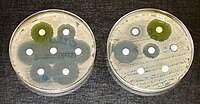
Photo from wikipedia
Background Rates of carbapenem-resistant Pseudomonas aeruginosa are increasing. Aggressive prevention strategies, including instituting antimicrobial stewardship programmes, are essential for combating antimicrobial resistance. Objectives We conducted this study to compare the… Click to show full abstract
Background Rates of carbapenem-resistant Pseudomonas aeruginosa are increasing. Aggressive prevention strategies, including instituting antimicrobial stewardship programmes, are essential for combating antimicrobial resistance. Objectives We conducted this study to compare the antimicrobial susceptibility pattern of P. aeruginosa before and after carbapenem restriction. Methods We conducted a two-phase retrospective study in an adult ICU. The first phase was from May until July 2016 (before carbapenem restriction), whereas the second phase was from September until November 2016 (while implementing carbapenem restriction). The antimicrobial susceptibility pattern of P. aeruginosa was reviewed in August and December 2016. The measure of carbapenem-resistant P. aeruginosa was the proportion of resistant isolates (percentage resistant). The measure of antibacterial consumption in the study phases was DDDs/1000 patient days. Results The overall carbapenem consumption decreased significantly in the second phase, from 28.44 to 11.67 DDDs/1000 patient days (P = 0.012). The resistance of P. aeruginosa to imipenem and meropenem decreased significantly from 76.0% to 38.5% (P = 0.019) and from 74.1% to 30.0% (P = 0.012), respectively. Susceptibility of P. aeruginosa to other antibacterials was not affected by carbapenem restriction. Conclusions These data suggest that restricting carbapenems, even for a short duration, may be an effective strategy for managing the problem of carbapenem resistance in P. aeruginosa.
Journal Title: Journal of Antimicrobial Chemotherapy
Year Published: 2017
Link to full text (if available)
Share on Social Media: Sign Up to like & get
recommendations!